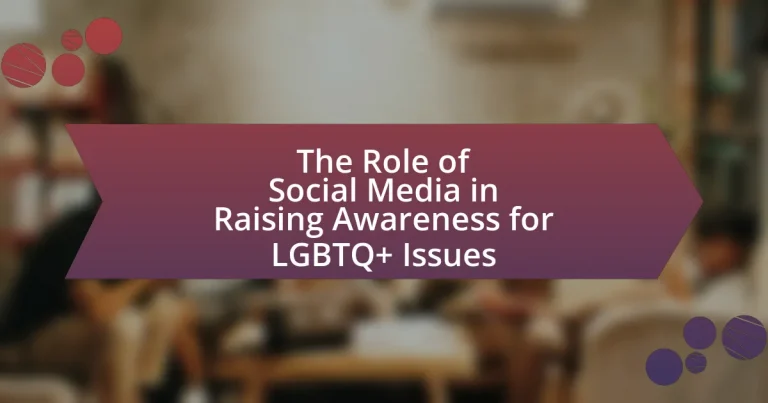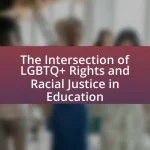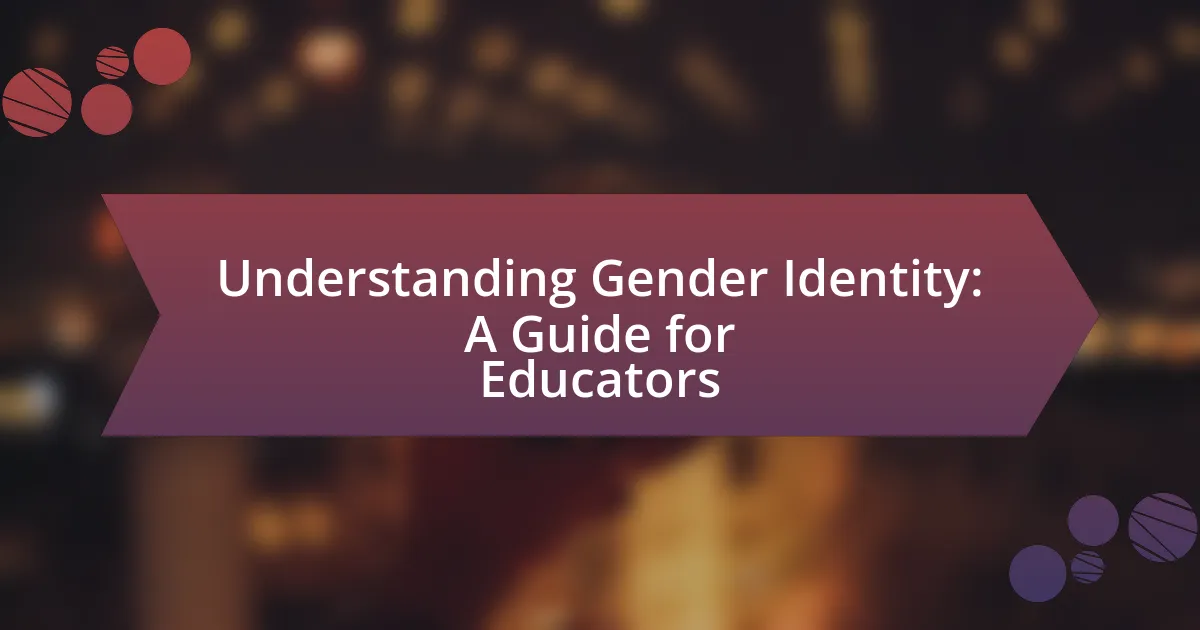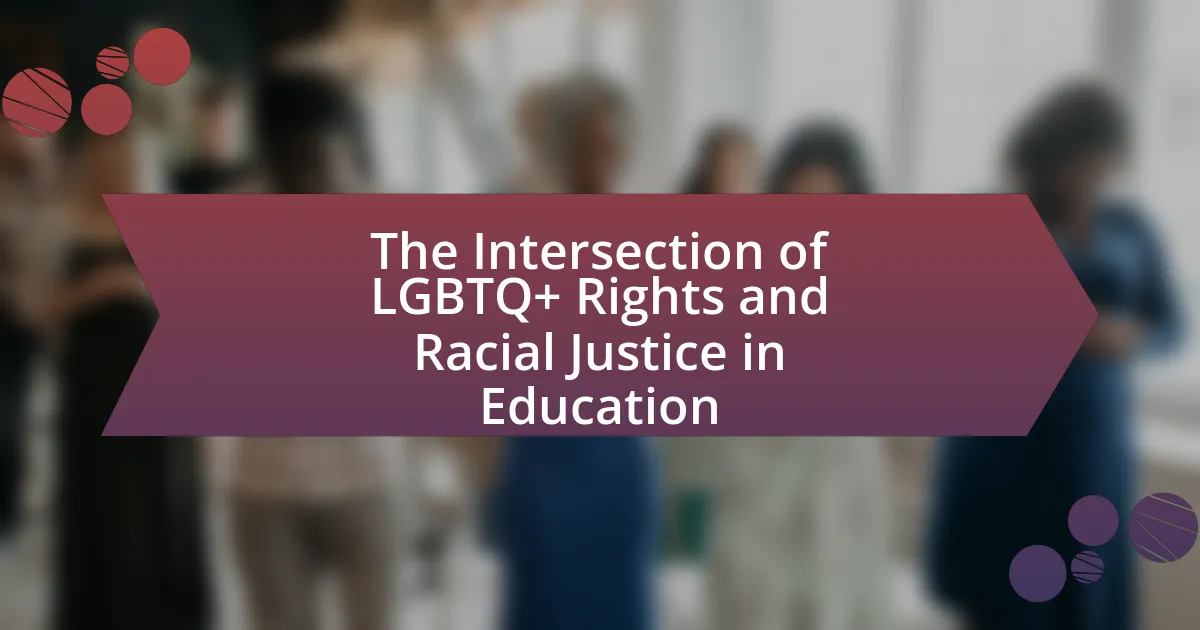The article examines the significant role of social media in raising awareness for LGBTQ+ issues, highlighting its impact on visibility, community building, and advocacy. It discusses how platforms like Instagram, Twitter, and TikTok facilitate the sharing of personal stories and educational content, which fosters understanding and acceptance. The article also explores the effectiveness of social media campaigns, the engagement of different demographics with LGBTQ+ content, and the challenges faced, such as misinformation and online harassment. Additionally, it outlines the importance of raising awareness for LGBTQ+ rights and the potential for social media to influence policy changes and societal attitudes.

What is the Role of Social Media in Raising Awareness for LGBTQ+ Issues?
Social media plays a crucial role in raising awareness for LGBTQ+ issues by providing a platform for visibility, community building, and advocacy. It allows individuals and organizations to share personal stories, educational content, and resources, which can foster understanding and acceptance. For instance, campaigns like #LoveIsLove and #PrideMonth have mobilized millions, highlighting LGBTQ+ rights and experiences globally. Research indicates that social media can significantly influence public opinion; a study by the Pew Research Center found that 70% of LGBTQ+ individuals believe social media has positively impacted their visibility and acceptance in society.
How has social media transformed the conversation around LGBTQ+ issues?
Social media has significantly transformed the conversation around LGBTQ+ issues by providing a platform for visibility, advocacy, and community building. This transformation is evident in the rapid dissemination of information, allowing marginalized voices to share their experiences and challenges directly with a global audience. For instance, the hashtag #LoveIsLove gained widespread traction during the fight for marriage equality, mobilizing support and raising awareness about LGBTQ+ rights. Additionally, studies show that social media campaigns have led to increased public support for LGBTQ+ rights, with a 2019 survey indicating that 70% of Americans support same-sex marriage, a rise attributed in part to social media advocacy. Thus, social media has played a crucial role in shaping public discourse and fostering a more inclusive environment for LGBTQ+ individuals.
What platforms are most effective in promoting LGBTQ+ awareness?
Social media platforms such as Instagram, Twitter, and TikTok are most effective in promoting LGBTQ+ awareness. These platforms facilitate the rapid sharing of personal stories, educational content, and community support, which are crucial for raising awareness. For instance, Instagram’s visual nature allows users to share impactful imagery and videos that resonate emotionally, while Twitter’s real-time engagement fosters discussions and activism. TikTok’s algorithm promotes diverse voices and creative expression, making it a powerful tool for reaching younger audiences. According to a 2021 report by GLAAD, 80% of LGBTQ+ youth feel more connected to their community through social media, highlighting its role in fostering awareness and support.
How do different demographics engage with LGBTQ+ content on social media?
Different demographics engage with LGBTQ+ content on social media in varied ways, influenced by factors such as age, gender, and cultural background. For instance, younger users, particularly those aged 18-29, are more likely to interact with LGBTQ+ content through likes, shares, and comments, as evidenced by a 2021 Pew Research Center study showing that 63% of this age group supports LGBTQ+ rights and actively engages with related content. In contrast, older demographics, such as those over 50, tend to engage less frequently, often due to generational attitudes towards LGBTQ+ issues. Additionally, gender differences are notable; women are generally more supportive and engaged with LGBTQ+ content compared to men, with studies indicating that 70% of women express positive attitudes towards LGBTQ+ representation online. Cultural background also plays a significant role, as individuals from more conservative cultures may engage less openly with LGBTQ+ content due to societal norms. Overall, engagement levels and types of interaction with LGBTQ+ content on social media are shaped by these demographic factors.
Why is raising awareness for LGBTQ+ issues important?
Raising awareness for LGBTQ+ issues is important because it fosters understanding, acceptance, and equality within society. Increased awareness leads to reduced discrimination and violence against LGBTQ+ individuals, as evidenced by studies showing that communities with higher awareness levels report lower rates of hate crimes. Furthermore, awareness initiatives can improve mental health outcomes for LGBTQ+ individuals; research from the American Psychological Association indicates that visibility and support significantly reduce the risk of depression and anxiety in LGBTQ+ youth. Therefore, raising awareness not only promotes social justice but also enhances the well-being of marginalized communities.
What impact does awareness have on societal attitudes towards LGBTQ+ individuals?
Awareness significantly improves societal attitudes towards LGBTQ+ individuals by fostering understanding and reducing stigma. Research indicates that increased awareness through education and representation leads to greater acceptance; for instance, a study by the Williams Institute found that states with comprehensive LGBTQ+ education programs saw a 20% increase in support for LGBTQ+ rights. This correlation demonstrates that when individuals are informed about LGBTQ+ issues, they are more likely to challenge stereotypes and embrace diversity, ultimately contributing to a more inclusive society.
How does increased awareness contribute to policy changes and legal protections?
Increased awareness contributes to policy changes and legal protections by mobilizing public opinion and influencing decision-makers. When social media campaigns highlight LGBTQ+ issues, they create a sense of urgency and empathy among the general public, which can lead to increased advocacy for legislative reforms. For instance, the widespread visibility of LGBTQ+ rights movements on platforms like Twitter and Instagram has resulted in significant policy shifts, such as the legalization of same-sex marriage in various countries, driven by public support and pressure on lawmakers. Research indicates that social media can amplify marginalized voices, leading to greater visibility and support for policy initiatives aimed at enhancing legal protections for LGBTQ+ individuals.
What challenges does social media face in promoting LGBTQ+ awareness?
Social media faces significant challenges in promoting LGBTQ+ awareness, primarily due to misinformation, harassment, and algorithmic bias. Misinformation can spread rapidly on platforms, leading to misconceptions about LGBTQ+ identities and issues, which undermines awareness efforts. Harassment and hate speech directed at LGBTQ+ individuals can create a hostile environment, discouraging open discussions and sharing of experiences. Additionally, algorithmic bias may limit the visibility of LGBTQ+ content, as algorithms often prioritize mainstream narratives over marginalized voices, resulting in reduced reach and engagement for LGBTQ+ advocacy posts. These factors collectively hinder the effectiveness of social media as a tool for raising awareness about LGBTQ+ issues.
How do misinformation and negative narratives affect LGBTQ+ representation online?
Misinformation and negative narratives significantly undermine LGBTQ+ representation online by perpetuating stereotypes and fostering discrimination. These harmful narratives can lead to a distorted public perception of LGBTQ+ individuals, often portraying them in a negative light that reinforces societal biases. For instance, studies have shown that negative portrayals in media can contribute to increased rates of bullying and mental health issues among LGBTQ+ youth, as highlighted in research by the Trevor Project, which found that 40% of LGBTQ+ youth reported being bullied due to their sexual orientation or gender identity. Furthermore, misinformation can create barriers to understanding LGBTQ+ issues, leading to a lack of support and acceptance within communities. This cycle of negativity not only affects individual experiences but also hinders broader societal progress toward equality and acceptance for LGBTQ+ individuals.
What role do algorithms play in shaping LGBTQ+ content visibility?
Algorithms significantly influence LGBTQ+ content visibility by determining which posts are prioritized in users’ feeds. Social media platforms utilize algorithms that analyze user behavior, engagement, and preferences to curate content, often amplifying posts that resonate with a broader audience. For instance, research by the Pew Research Center indicates that algorithms can create echo chambers, where users are predominantly exposed to content that aligns with their interests, potentially sidelining diverse LGBTQ+ narratives. This selective visibility can enhance awareness for some LGBTQ+ issues while marginalizing others, impacting the overall representation within digital spaces.
How can social media campaigns effectively raise awareness for LGBTQ+ issues?
Social media campaigns can effectively raise awareness for LGBTQ+ issues by leveraging targeted messaging, community engagement, and visual storytelling. Targeted messaging allows campaigns to reach specific demographics, ensuring that the content resonates with the audience, as seen in campaigns like the Human Rights Campaign’s “Love is Love,” which utilized relatable narratives to connect with viewers. Community engagement fosters a sense of belonging and support, exemplified by initiatives such as Pride Month celebrations on platforms like Instagram, where users share personal stories and experiences, amplifying visibility. Visual storytelling, through impactful images and videos, captures attention and evokes emotional responses, as demonstrated by the viral success of campaigns like #LoveWins, which celebrated the legalization of same-sex marriage in the U.S. These strategies collectively enhance the effectiveness of social media campaigns in promoting LGBTQ+ awareness and advocacy.
What strategies have proven successful in past LGBTQ+ awareness campaigns?
Successful strategies in past LGBTQ+ awareness campaigns include leveraging social media platforms, utilizing storytelling, and fostering community engagement. Social media has proven effective due to its ability to reach diverse audiences quickly; for instance, campaigns like the #LoveIsLove movement gained significant traction on platforms like Twitter and Instagram, leading to increased visibility and support for LGBTQ+ rights. Storytelling, particularly through personal narratives shared online, has humanized LGBTQ+ experiences and fostered empathy, as seen in campaigns like “It Gets Better,” which provided hope and support to LGBTQ+ youth. Additionally, community engagement through events such as Pride parades and local activism has mobilized support and created safe spaces for dialogue, reinforcing the importance of visibility and representation in driving social change.
How can influencers and activists leverage social media for greater impact?
Influencers and activists can leverage social media for greater impact by creating engaging content that resonates with their audience and promotes awareness of LGBTQ+ issues. By utilizing platforms like Instagram, Twitter, and TikTok, they can share personal stories, educational resources, and calls to action that encourage followers to engage with and support LGBTQ+ rights. Research indicates that social media campaigns can significantly increase visibility and support for social movements; for instance, the #LoveIsLove campaign during the legalization of same-sex marriage in the U.S. mobilized millions and raised awareness effectively. This demonstrates that strategic content creation and community engagement on social media can lead to tangible societal change.

What are the specific impacts of social media on LGBTQ+ communities?
Social media significantly impacts LGBTQ+ communities by providing platforms for visibility, support, and activism. These platforms enable LGBTQ+ individuals to share their experiences, connect with others, and access resources, fostering a sense of belonging. For instance, a 2020 study by the Pew Research Center found that 63% of LGBTQ+ adults reported that social media helps them feel more connected to their community. Additionally, social media campaigns have successfully raised awareness about LGBTQ+ issues, influencing public opinion and policy changes, such as the legalization of same-sex marriage in various countries. This demonstrates that social media serves as a crucial tool for empowerment and advocacy within LGBTQ+ communities.
How does social media foster community and support among LGBTQ+ individuals?
Social media fosters community and support among LGBTQ+ individuals by providing platforms for connection, expression, and resource sharing. These platforms enable users to find like-minded individuals, share personal experiences, and access information about LGBTQ+ rights and health resources. For instance, a study published in the Journal of Homosexuality found that 70% of LGBTQ+ youth reported feeling more connected to their community through social media. Additionally, social media campaigns, such as the #LoveIsLove movement, have raised awareness and solidarity, further strengthening community bonds.
What role do online support groups play in the lives of LGBTQ+ youth?
Online support groups play a crucial role in the lives of LGBTQ+ youth by providing a safe space for connection, validation, and resources. These platforms enable young individuals to share their experiences, seek advice, and find community support, which is essential for their mental health and well-being. Research indicates that LGBTQ+ youth who engage in online support groups report lower levels of depression and anxiety, highlighting the positive impact of these communities. For instance, a study published in the Journal of Youth and Adolescence found that participation in online support networks significantly enhances feelings of belonging and reduces isolation among LGBTQ+ youth.
How do social media platforms facilitate connections between LGBTQ+ individuals and allies?
Social media platforms facilitate connections between LGBTQ+ individuals and allies by providing inclusive spaces for communication, support, and community building. These platforms enable users to share personal stories, experiences, and resources, fostering a sense of belonging and solidarity. For instance, studies show that 70% of LGBTQ+ individuals report feeling more connected to their community through social media interactions, which can lead to increased visibility and advocacy for LGBTQ+ rights. Additionally, features such as groups, hashtags, and live events allow for real-time engagement and mobilization, further strengthening the ties between LGBTQ+ individuals and their allies.
What are the risks associated with LGBTQ+ advocacy on social media?
LGBTQ+ advocacy on social media carries several risks, including harassment, doxxing, and misinformation. Individuals advocating for LGBTQ+ rights may face targeted harassment from anti-LGBTQ+ groups, which can lead to emotional distress and safety concerns. Doxxing, the act of publicly revealing personal information, poses a significant threat, as it can result in real-world violence or stalking. Additionally, misinformation can spread rapidly on social media platforms, undermining the credibility of LGBTQ+ issues and creating confusion among the public. According to a 2021 report by the Human Rights Campaign, 80% of LGBTQ+ individuals reported experiencing online harassment, highlighting the pervasive nature of these risks.
How can online harassment affect LGBTQ+ activists and their campaigns?
Online harassment can significantly undermine LGBTQ+ activists and their campaigns by creating a hostile environment that discourages participation and silences voices. This harassment often manifests as targeted threats, hate speech, and doxxing, which can lead to emotional distress and a decrease in the activists’ ability to effectively mobilize support. Research indicates that 73% of LGBTQ+ individuals have experienced online harassment, which can result in reduced engagement in advocacy efforts and a retreat from public discourse. Consequently, the effectiveness of campaigns aimed at raising awareness for LGBTQ+ issues diminishes, as activists may feel unsafe or unsupported in their efforts.
What measures can be taken to protect LGBTQ+ individuals from online threats?
To protect LGBTQ+ individuals from online threats, implementing robust privacy settings and utilizing secure communication platforms are essential measures. These actions help safeguard personal information and reduce the risk of harassment. Research indicates that 73% of LGBTQ+ individuals have experienced online harassment, highlighting the need for effective protective strategies. Additionally, educating users about recognizing and reporting online abuse can empower LGBTQ+ individuals to take action against threats. Organizations like the Human Rights Campaign provide resources and guidelines for safe online practices, reinforcing the importance of community support in combating online dangers.
What future trends can we expect in the role of social media for LGBTQ+ issues?
Future trends in the role of social media for LGBTQ+ issues include increased visibility and representation, enhanced community engagement, and the use of advanced technologies like AI for advocacy. Social media platforms are evolving to prioritize diverse voices, leading to more authentic representation of LGBTQ+ individuals and their experiences. For instance, campaigns like #LoveIsLove have gained traction, showcasing the power of social media in promoting equality and acceptance. Additionally, social media will likely facilitate greater collaboration among LGBTQ+ organizations, allowing for more effective mobilization and resource sharing. The integration of AI tools can also help in analyzing trends and sentiments, enabling targeted advocacy efforts. These trends indicate a growing recognition of the importance of social media in shaping public discourse and policy related to LGBTQ+ rights.
How might emerging technologies influence LGBTQ+ advocacy on social media?
Emerging technologies significantly enhance LGBTQ+ advocacy on social media by providing innovative tools for communication and outreach. These technologies, such as artificial intelligence, augmented reality, and blockchain, enable more targeted campaigns, allowing advocates to reach specific demographics effectively. For instance, AI algorithms can analyze user behavior and preferences, facilitating personalized content that resonates with diverse LGBTQ+ communities. Additionally, augmented reality can create immersive experiences that raise awareness about LGBTQ+ issues, fostering empathy and understanding among broader audiences. Furthermore, blockchain technology can ensure transparency and security in fundraising efforts for LGBTQ+ organizations, building trust within the community. These advancements collectively empower advocates to mobilize support, disseminate information rapidly, and engage users in meaningful ways, ultimately amplifying the visibility and impact of LGBTQ+ issues on social media platforms.
What potential changes in user behavior could impact LGBTQ+ awareness efforts?
Potential changes in user behavior that could impact LGBTQ+ awareness efforts include increased engagement with LGBTQ+ content and shifts towards more inclusive language in online discussions. As users become more active in sharing personal stories and experiences related to LGBTQ+ issues, this can lead to greater visibility and understanding within their networks. Additionally, studies show that social media platforms have seen a rise in the use of hashtags related to LGBTQ+ advocacy, which can amplify messages and foster community support. For instance, the Human Rights Campaign reported a 50% increase in social media posts related to LGBTQ+ rights during Pride Month, indicating that user behavior directly influences awareness levels.

How can individuals contribute to raising awareness for LGBTQ+ issues on social media?
Individuals can contribute to raising awareness for LGBTQ+ issues on social media by sharing informative content, engaging in discussions, and amplifying LGBTQ+ voices. Sharing articles, personal stories, and educational resources helps to inform followers about LGBTQ+ rights and challenges, fostering understanding and empathy. Engaging in discussions allows individuals to challenge misconceptions and promote inclusivity, while amplifying LGBTQ+ voices ensures that marginalized perspectives are heard. According to a 2021 study by the Pew Research Center, 70% of social media users believe that these platforms are effective for raising awareness about social issues, highlighting the significant impact individuals can have in promoting LGBTQ+ awareness through their online presence.
What practical steps can individuals take to support LGBTQ+ causes online?
Individuals can support LGBTQ+ causes online by actively engaging in advocacy through social media platforms. This includes sharing informative content, such as articles and videos that highlight LGBTQ+ issues, which can raise awareness among followers. Additionally, individuals can participate in online campaigns and petitions that promote LGBTQ+ rights, thereby amplifying the voices of marginalized communities. Supporting LGBTQ+ organizations by donating or volunteering time for virtual events also contributes to the cause. According to a 2021 report by the Human Rights Campaign, social media campaigns significantly increase visibility and support for LGBTQ+ issues, demonstrating the impact of online advocacy.
How can sharing personal stories enhance LGBTQ+ visibility and understanding?
Sharing personal stories enhances LGBTQ+ visibility and understanding by humanizing experiences and fostering empathy among diverse audiences. When individuals share their narratives, they provide insight into the challenges and triumphs faced by the LGBTQ+ community, which can counter stereotypes and misconceptions. Research indicates that personal storytelling can significantly increase awareness and acceptance; for instance, a study published in the Journal of Homosexuality found that exposure to personal accounts of LGBTQ+ individuals led to greater support for LGBTQ+ rights among heterosexual participants. This process of sharing not only amplifies marginalized voices but also encourages dialogue, creating a more inclusive environment that promotes understanding and acceptance.
What are effective ways to engage with LGBTQ+ content and communities on social media?
Effective ways to engage with LGBTQ+ content and communities on social media include actively following LGBTQ+ organizations, participating in discussions, and sharing relevant content. Following organizations such as GLAAD or The Trevor Project provides access to valuable resources and updates on LGBTQ+ issues. Engaging in discussions by commenting on posts or joining LGBTQ+ groups fosters community interaction and support. Sharing content that highlights LGBTQ+ stories, events, or advocacy efforts amplifies visibility and raises awareness. Research indicates that social media platforms are crucial for community building and activism, with 70% of LGBTQ+ individuals reporting that social media helps them connect with others who share similar experiences.
What resources are available for individuals looking to advocate for LGBTQ+ issues?
Individuals looking to advocate for LGBTQ+ issues can access various resources, including organizations, online platforms, and educational materials. Notable organizations such as the Human Rights Campaign and GLAAD provide advocacy tools, training, and information on LGBTQ+ rights. Social media platforms like Twitter and Instagram serve as vital spaces for sharing information, mobilizing support, and connecting with like-minded advocates. Additionally, educational resources such as the “LGBTQ+ Advocacy Toolkit” by the National LGBTQ Task Force offer practical guidance on effective advocacy strategies. These resources collectively empower individuals to engage in meaningful advocacy for LGBTQ+ rights and awareness.
Where can individuals find educational materials on LGBTQ+ rights and history?
Individuals can find educational materials on LGBTQ+ rights and history through various reputable sources, including organizations like the Human Rights Campaign, GLAAD, and the American Civil Liberties Union. These organizations provide comprehensive resources, including articles, reports, and educational toolkits that cover significant historical events, legal milestones, and current issues affecting the LGBTQ+ community. For instance, the Human Rights Campaign offers a detailed timeline of LGBTQ+ history and resources for advocacy, while GLAAD focuses on media representation and its impact on public perception. Additionally, academic institutions often publish research papers and host events that further educate the public on LGBTQ+ rights and history.
What organizations offer support for LGBTQ+ advocacy efforts on social media?
Organizations that offer support for LGBTQ+ advocacy efforts on social media include the Human Rights Campaign, GLAAD, and The Trevor Project. The Human Rights Campaign focuses on promoting equality and provides resources for social media campaigns. GLAAD works to ensure fair representation of LGBTQ+ individuals in media and offers tools for effective advocacy online. The Trevor Project provides crisis intervention and suicide prevention services to LGBTQ+ youth, utilizing social media to reach and support this demographic. These organizations have established a significant presence on social media platforms, leveraging their reach to raise awareness and mobilize support for LGBTQ+ issues.





